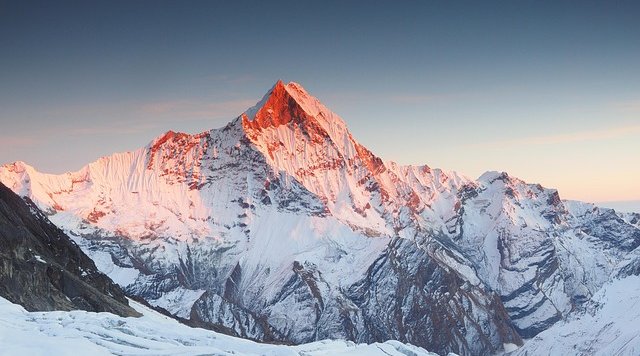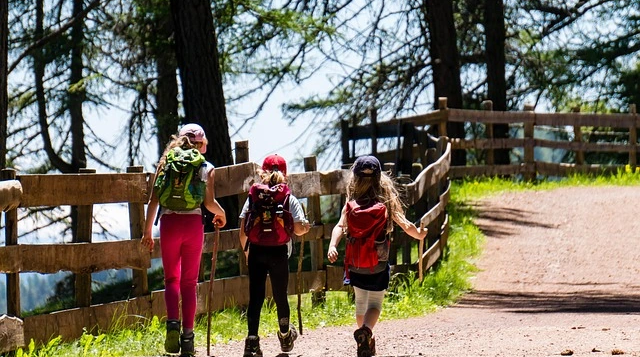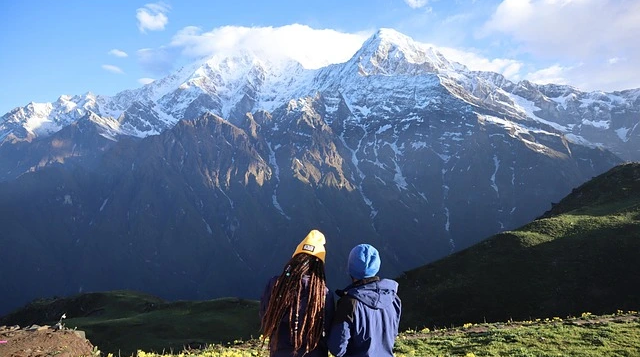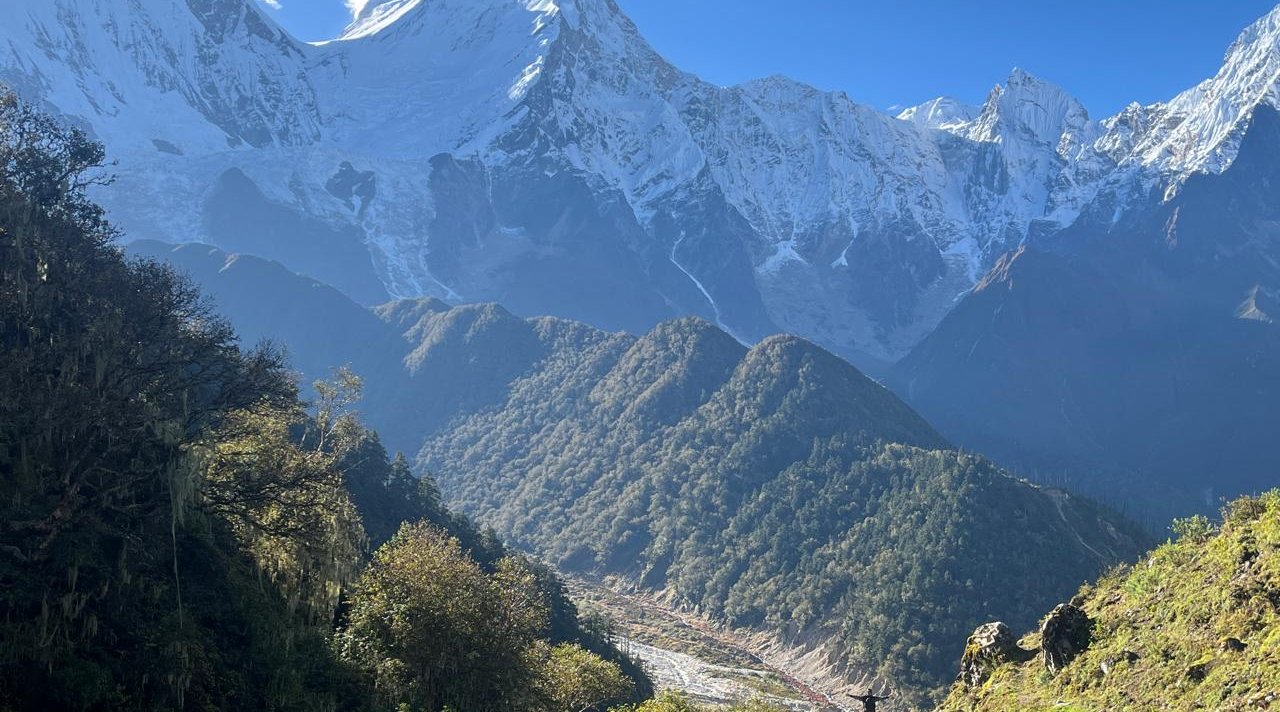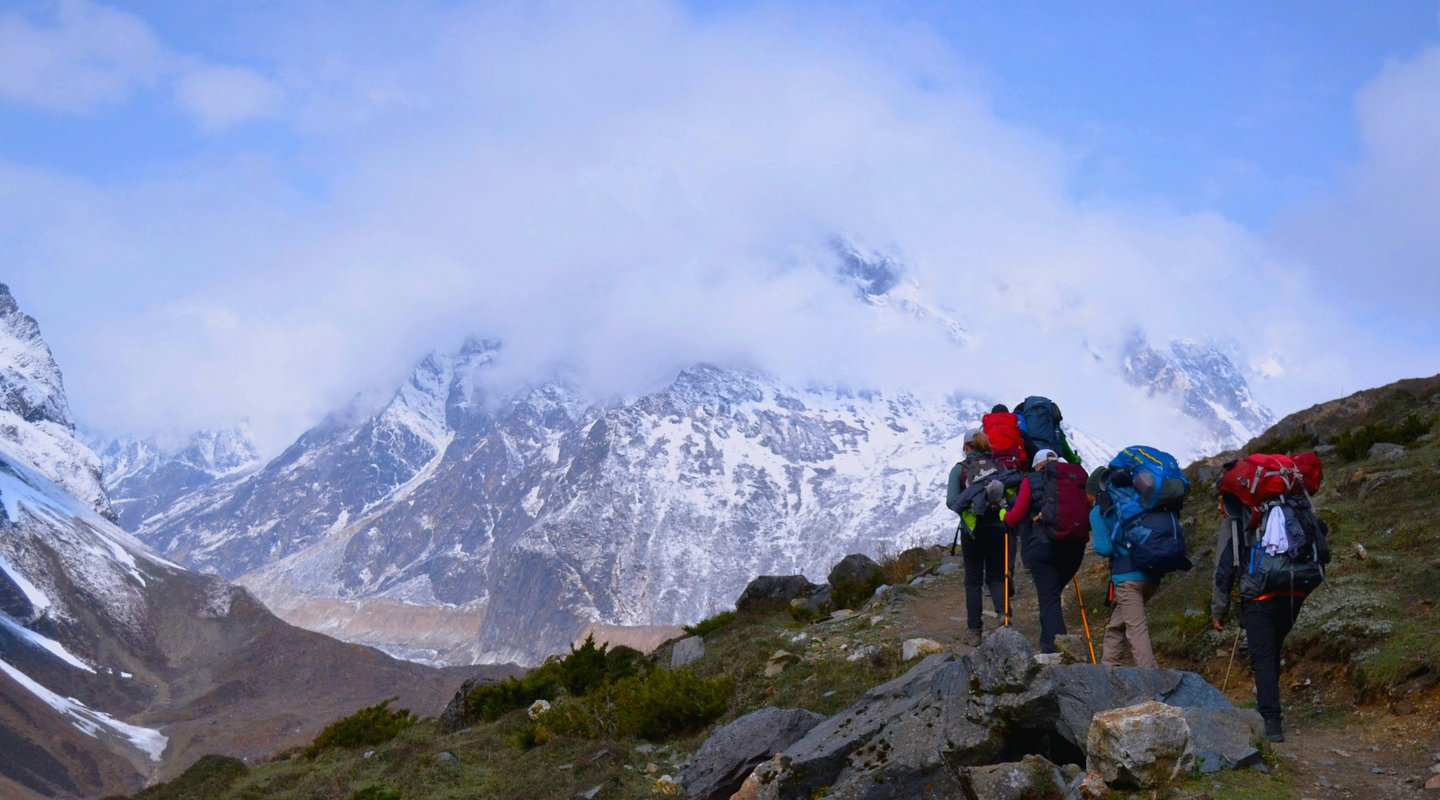Picture this: You're standing at 4,130 meters, surrounded by a natural amphitheater of the world's most formidable peaks. The sun's first rays kiss Annapurna I's summit, painting ice walls in shades of gold and rose. This is Annapurna Base Camp—but which route brought you here? The bustling South with its teahouse comforts, or the wild North with its pristine solitude?
Choosing between the North Annapurna Base Camp vs South Annapurna Base Camp trek isn't just about picking a path—it's about deciding what kind of adventure speaks to your soul. Do you crave the camaraderie of fellow trekkers and the comfort of warm lodges? Or does your heart yearn for untouched natural beauty and the challenge of camping beneath star-studded Himalayan skies? This comprehensive comparison of North ABC vs South ABC routes will help you navigate this crucial decision, weighing every factor from difficulty levels to cultural experiences, costs to crowd levels.
Route Comparison: North Annapurna Base Camp vs South Annapurna Base Camp Paths
The fundamental difference between these treks begins with geography and infrastructure. The South Annapurna Base Camp trek follows the well-established Annapurna sanctuary trek route, while the North offers one of Nepal's true Himalayan off-beaten paths.
South ABC Route Profile:
- Distance: 110-115 km round trip
- Duration: 7-12 days
- Starting point: Nayapul or Kimche
- Highest point: 4,130m at ABC
- Daily elevation gain: 400-700m
- Trail type: Well-marked, stone-stepped paths
North ABC Route Profile:
- Distance: 70-80 km round trip
- Duration: 7-10 days
- Starting point: Humkhola via Pokhara
- Highest point: 4,200m at North ABC
- Daily elevation gain: 500-800m
- Trail type: Remote mountain paths, some sections unmarked
The North ABC vs South ABC trek difficulty presents interesting contrasts. While the South's longer distance might seem more challenging, its gradual ascent and established infrastructure make it more manageable for beginners. The North's shorter distance is deceptive—steeper sections and route-finding requirements demand stronger mountain skills. Have you considered how comfortable you are navigating without clear trail markers? This question often determines which ABC trek is better for beginners in Nepal.
The North Annapurna Base Camp elevation profile shows more dramatic daily gains, testing your fitness differently than the South's steady climb. Glacier views on ABC routes differ significantly too: the South offers the famous Machapuchare base camp comparison point with its iconic fishtail peak, while the North provides unobstructed vistas of Annapurna I north face—the very wall that challenged Maurice Herzog in 1950.
Accommodation Differences: Comfort vs. Wilderness in North ABC vs South ABC
Perhaps no factor divides these treks more starkly than where you'll rest your head each night. This fundamental difference shapes not just comfort levels but the entire trekking experience when comparing North Annapurna Base Camp vs South Annapurna Base Camp options.
South ABC Accommodation:
- Established teahouses every 1-2 hours of walking
- Private rooms available (though basic)
- Hot showers in most locations (for a fee)
- Diverse menu options including Western dishes
- WiFi and charging stations widely available
- Social atmosphere with fellow trekkers
North ABC Accommodation:
- Camping required for most of the route
- Basic homestays in villages like Narchyang
- Limited teahouses only in lower sections
- Carry all camping equipment or arrange porter support
- Meals prepared by trekking staff or self-catered
- Authentic cultural immersion trek Nepal experience
The contrast extends beyond mere logistics. Tea houses South ABC vs camping North creates entirely different rhythms. On the South, you'll share dal bhat dinners with trekkers from around the globe, swapping stories in warm common rooms. The North demands self-sufficiency but rewards with evenings spent around campfires, listening to porter songs under pristine skies. Which appeals more: the convenience of arriving to a ready bed, or the adventure of selecting your own campsite beside a glacial stream?
Crowd Factors: Choosing Your Social Scene
If solitude ranks high on your priority list, this section might be your decision-maker. The popularity gap between North ABC vs South ABC routes is staggering, fundamentally altering the trekking experience.
South ABC Crowd Levels:
- Peak season: 500-800 trekkers daily
- Shoulder season: 200-400 trekkers daily
- Bottlenecks at narrow trail sections
- Busy teahouses requiring early arrival for rooms
- Popular photo spots with queues at sunrise
North ABC Crowd Levels:
- Peak season: 20-50 trekkers daily
- Shoulder season: 5-20 trekkers daily
- Entire days without encountering other groups
- Camping spots always available
- Uninterrupted photo opportunities
The solitary trekking experience north offers something increasingly rare in Nepal's popular regions. While the South buzzes with international energy, the North preserves that sense of exploration. Remote Himalayan base camp experiences on the North include wildlife spotting Annapurna opportunities—blue sheep, Himalayan tahr, even elusive snow leopards—creatures that avoid the South's busy trails.
Best season for North Annapurna trek to avoid crowds falls during shoulder seasons: late September and late November. Even during peak October, you'll encounter more yaks than trekkers. The South maintains crowds throughout its accessible seasons, though early June and late November offer slightly quieter experiences.
Natural Beauty & Cultural Immersion: North Annapurna Base Camp vs South Annapurna Base Camp
Both routes showcase the biodiversity of the Annapurna region, but in distinctly different ways. The South's established trail passes through diverse ecosystems, from subtropical bamboo forests to alpine meadows. The North's wilder terrain offers more dramatic transitions and pristine landscapes.
South ABC Natural Highlights:
- Terraced farmlands transitioning to forests
- Rhododendron forests Annapurna (spectacular in spring)
- Modi Khola gorge with dramatic waterfalls
- Hinku Cave and avalanche viewpoints
- 360-degree mountain panorama at ABC
North ABC Natural Highlights:
- Narchyang Lake north ABC with mirror-like reflections
- Panchakunda Lake adventure series at high altitude
- Untouched rhododendron blooms spring trek
- Multiple waterfall hiking routes Annapurna
- Pristine alpine terrain comparison opportunities
- Direct Annapurna North face route details views
Cultural experiences differ markedly too when comparing North ABC vs South ABC trails. The South's Gurung village experiences feel more commercialized, with traditional dances performed for trekker audiences. Villages have adapted to tourism, offering pizza alongside dal bhat. The North preserves authentic rhythms—you'll witness genuine cultural experiences that Gurung villages South ABC cannot match. In Narchyang, festivals happen for villagers, not visitors. Your presence becomes part of daily life rather than an economic transaction.
Cost Analysis: Budget Implications for 2026
Understanding the financial commitment helps set realistic expectations. The South Annapurna Base Camp trek cost 2026 appears lower initially but includes hidden expenses. The North's upfront costs seem higher but often provide better value in the North ABC vs South ABC comparison.
South ABC Budget Breakdown (per person):
- Permits: $30-50 (ACAP + TIMS)
- Accommodation: $5-10/night × 10 nights = $50-100
- Meals: $25-30/day × 10 days = $250-300
- Hot showers/charging: $50-80 total
- Guide (optional): $25-30/day
- Porter (optional): $18-22/day
- Total: $400-650 (independent) or $800-1,200 (guided)
North ABC Budget Breakdown (per person):
- Permits for North Annapurna Base Camp: $30-50
- Camping equipment rental: $150-200
- Food and cooking gas: $15-20/day × 8 days = $120-160
- Guide (recommended): $30-35/day
- Porter (essential for equipment): $20-25/day
- Transportation to Humkhola: $50-80
- Total: $650-900 (independent) or $1,000-1,500 (guided)
Budget trekking North ABC Nepal 2026 requires careful planning but delivers exceptional value through exclusive experiences. Consider that South ABC's "extras" add up quickly—that tempting apple pie and hot shower after a long day can double your daily budget. The North's all-inclusive camping approach provides cost certainty and often works out similarly priced when comparing total expenses.
Unique Value-Add: Decision Matrix for North ABC vs South ABC
To crystallize your decision, let's examine the key factors that differentiate these treks:
Difficulty Level: The South ABC offers a moderate trek with gradual ascent patterns, making it ideal for beginners. The North ABC presents a moderate-to-challenging experience with steeper sections that demand better fitness and mountain experience.
Crowd Dynamics: If you're seeking pristine solitude, the North ABC delivers with only 20-50 trekkers daily even in peak season. The South ABC buzzes with 500-800 daily trekkers during high season, creating a social but crowded atmosphere.
Accommodation Comfort: The South's established teahouses provide reliable comfort with beds, varied menus, and hot showers. The North's wilderness camping offers authentic adventure but requires carrying gear and tolerating basic conditions.
Cost Structure: While the South ABC appears cheaper initially with lower upfront costs, hidden expenses for meals, showers, and charging add up quickly. The North's higher initial investment includes most expenses, offering better budget predictability.
Scenic Value: The South showcases classic Himalayan beauty that matches every postcard you've seen. The North reveals raw, untouched vistas that few eyes have witnessed, particularly the unobstructed Annapurna I north face views.
Cultural Authenticity: Tourist adaptation has transformed the South's villages into comfortable but commercialized stops. The North preserves genuine village life where your presence becomes part of daily rhythms rather than economic transactions.
Infrastructure & Safety: The South's excellent infrastructure includes marked trails, regular teahouses, and reliable emergency evacuation options. The North's basic infrastructure demands self-reliance and careful planning for emergencies.
Photography Opportunities: Crowded viewpoints on the South often mean waiting for your perfect shot. The North offers exclusive photography conditions where you control the scene without competition.
Weather Flexibility: The South's indoor shelter network allows flexibility during storms. The North's camping requires weather-resistant gear and potential schedule adjustments for severe conditions.
Practical Considerations
Beyond the romantic notions of trekking, practical factors often determine success. The South's infrastructure advantages become apparent during emergencies—helicopter evacuations are routine, and communication remains reliable. The North's remoteness means self-reliance is essential when choosing between North Annapurna Base Camp vs South Annapurna Base Camp routes.
Packing list for North ABC trek Nepal essentials:
- Four-season sleeping bag (rated -15°C)
- Sturdy camping tent (if not provided)
- Portable water purification system
- Comprehensive first aid kit
- Emergency shelter and signaling devices
- Extra days of food for weather delays
Solo trekking North ABC vs South ABC presents stark differences. The South's solo-friendly infrastructure makes independent trekking feasible for experienced hikers. The North demands either joining a group or hiring support staff—solo camping in remote areas poses significant risks. Frostbite risks at high altitude ABC Nepal affect both routes equally, but proximity to help differs dramatically.
Guided tours Maurice Herzog Trail North ABC often combine historical storytelling with practical support, adding cultural depth to the journey. The South's guides, while knowledgeable, often follow scripts repeated hundreds of times per season. Weather conditions on Annapurna Base Camp routes vary too: the South's teahouses offer shelter during storms, while the North requires battening down tents and potentially waiting out bad weather.
Making Your Choice
The best ABC route for beginners typically leads south—established infrastructure, clear trails, and abundant support create a forgiving environment for those new to Himalayan trekking. Yet don't dismiss the North too quickly. If you possess solid camping experience and crave authentic adventure, the North's challenges transform into rewards.
Consider your trekking goals when deciding between North Annapurna Base Camp vs South Annapurna Base Camp:
Choose South if: You're new to high-altitude trekking, prefer social interactions, value comfort and convenience, have limited time, or feel uncertain about remote wilderness navigation
Choose North if: You seek solitude and pristine nature, have camping/wilderness experience, want authentic cultural encounters, pursue unique photography, or previously completed popular treks
The fitness requirements for ABC trek variants differ subtly. The South's longer distance requires endurance, while the North's steeper sections demand explosive strength. Training should reflect your chosen route—long walks for the South, stair climbing and hill repeats for the North.
Conclusion: Your Perfect ABC Adventure Awaits
The North Annapurna Base Camp vs South Annapurna Base Camp trek debate has no universal answer—only the right choice for you. The South ABC offers the classic Himalayan teahouse experience: comfortable, social, and breathtakingly beautiful despite the crowds. It's the photograph you've seen a thousand times, finally captured through your own lens. The North ABC promises something rarer: a genuine wilderness experience in an increasingly connected world, where each vista feels personally discovered.
Want stories to share at dinner parties? The North's adventures—from camping beside Panchakunda Lake to navigating unmarked trails—create unforgettable narratives. Prefer relaxing with hot lemon tea while journaling your day? The South's teahouse comforts support contemplative travel. Both routes lead to Annapurna's heart, but the journey shapes the destination's meaning. Whether you choose the celebrated South or the secret North, you're embarking on a life-changing adventure. The mountains don't care which path you take—they'll challenge, inspire, and transform you regardless.
Ready to explore the untouched beauty of the North? Discover our expertly crafted North Annapurna Base Camp Trek package designed for adventurers seeking authentic wilderness experiences.
Contact our team for personalized trek planning:
Frequently Asked Questions
Which ABC trek is better for beginners Nepal?
The South ABC trek is generally better for beginners due to well-marked trails, teahouse infrastructure, and readily available support services throughout the route.
What's the cost comparison North ABC vs South ABC for 2026?
South ABC costs $400-650 independently or $800-1,200 guided, while North ABC runs $650-900 independently or $1,000-1,500 guided, with the North requiring camping equipment.
When is the best time for North Annapurna Base Camp vs South Annapurna Base Camp trek?
Both routes share optimal seasons: March-May and September-November, though the North offers better solitude in shoulder seasons like early September or late November.
How do permits for Annapurna Base Camp North South differ?
Both routes require the same permits (ACAP and TIMS), costing $30-50 total, though the North may need additional permissions for certain camping areas.
- What are the main duration North ABC vs South ABC differences?
South ABC typically takes 7-12 days covering 110-115km, while North ABC takes 7-10 days covering 70-80km, with the North featuring steeper, more challenging terrain.
customized Annapurna related packages at an affordable price:
South Annapurna Base camp trek
Annapurna Circuit trek 14 days
The Nar Phu Valley trek for beginners


